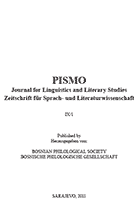Klasificiranje pridjeva u bosanskom jeziku
Classifying Adjectives in Bosnian Language
Author(s): Halid BulićSubject(s): Language and Literature Studies
Published by: Bosansko filološko društvo
Keywords: pridjevi; klasificiranje; deklinacija; indeklinabilni pridjev; pridjevski vid; komparacija; atribut; predikativ; reduplikacija; bosanski jezik
Summary/Abstract: The main aim of this paper was to present some classifications of adjectives in Bosnian language which are based on their grammatical features. The second aim was to show that classifications based on the meaning of adjectives have various weakness. Grammatical criteria suggested as a base of classifying adjectives the following: declinability; number and types of inflection paradigms that adjectives can have; comparability; ability to be used attributively and predicatively or only on one of these two ways and, at least, the abbility to be reduplicated. The following will state as well as exemlify the types of adjectives according to each classification criteria. According to declinability adjectives are divided into two groups: declinable (lijep, zelen) and indeclinable (nalik, fer, rahat, obrazli). With respect to numbers and types of inflection paradigms the declinable adjectives can be divided into three groups: adjectives with two inflection paradigms – nominal and adjectival-pronominal (zelen / zeleni); adjectives with only nominal inflection paradigm (kadar) and adjectives with only adjectival- pronominal inflection paradigm (bosanski, žarki). The adjectives with two paradigms can be divided into two groups with respect to the fact that they have one or two different nominative forms. Some of these adjectives have only one nominative form but two forms of genitive, dative and the other cases different than nominative (N dječakov, G dječakova / dječakovog...). The other of these adjectives have two different nominative form (N zelen / zeleni, G zelena / zelenog...). Adjectives can also be divided according to comparability into two groups: comparable (lijep, moderan) and incomparable adjectives (jednočlan, očev, vozački). With respect to ability to be used predicatively or attributively adjectives are divided into three groups: attributive-predicative adjectives (they can be used both attributively and predicatively: lijep, zlatan, pokvaren), adjectives attributiva tantum (they can be used only attributively: puki, bogovetni, dotični) and adjectives praedicativa tantum (they can be used only predicatively: kvit, rad). The fifth criterion suggested in this paper is the ability to be reduplicated. According to such criterion adjectives are divided into: reduplicable (pun, nov, go) and non-reduplicable (vruć, bratov, domaći). It should be taken into consideration that these are not the only grammatical criteria on which basis adjectives can be classified. Some of the grammatical criteria that are not mentioned in this paper are, for example, types of complementations that adjectives can have. Adjectives can also be divided according to the criteria that are not grammatical, for example, according to the origin or meaning. Such classifications have to be considered carefully and members of all such classes should not be considered as having the identical grammatical features, unless it is proved to be the case.
Journal: Pismo - Časopis za jezik i književnost
- Issue Year: 2011
- Issue No: 09
- Page Range: 11-38
- Page Count: 28
- Language: Bosnian

